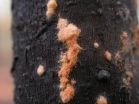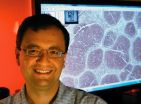(Press-News.org) Boston, MA—Scientists have found that free radicals (unstable molecules that cause the death of cells as the body ages) may also cause the damage in the eyes of patients with Fuchs Endothelial Corneal Dystrophy (FECD), a hereditary disease that is one of the most common reasons for corneal transplants worldwide.
The finding, published in the November 2010 American Journal of Pathology, holds promise for early and preventative treatments for this disease, which impacts nearly four percent of the population over age 60.
"Our discovery is significant, because it gives us the first hope for slowing the progression of the disease," says Dr. Ula V. Jurkunas, the principal investigator of the study, who is a scientist at Schepens Eye Research Institute and a corneal surgeon at Massachusetts Eye and Ear Infirmary in Boston. "If we can identify how free radicals are involved in this and what antioxidants can fight them, we can create a regimen that can help protect the cornea," she adds. (Antioxidants are molecules such as vitamins or certain proteins that bind with and neutralize free radicals.)
FECD destroys cells in the endothelial or deepest layer of the cornea, which is the clear tissue that makes up the front portion of the eye. These endothelial cells are equipped with pumps that expel excess water from the cornea and keep it clear. Without these cells, the cornea swells and vision clouds, and, in the late stages, vision is completely blocked.
Because corneal endothelial cells do not regenerate themselves, the only effective treatment for Fuchs has been corneal transplant, in which a surgeon removes the injured layer and replaces it with the donor endothelium.
While scientists have made progress in identifying some genes that cause the disease, they have made little or no progress in defining the mechanisms at play.
As a surgeon who performs hundreds of transplants, Jurkunas began to believe that a free radical process might be part of what is happening within the Fuchs dystrophy-plagued cornea. Free radicals are unstable molecules released by the body, which destabilize other molecules through a process known as oxidization, which causes cell death. Antioxidants are known to bind with and neutralize free radicals.
To test the theory, Jurkunas and her colleagues took numerous tissue samples from patients undergoing corneal transplants and tested them for evidence of free radical oxidation and subsequent tissue damage.
In the significant majority of specimens, the scientists found that the level of antioxidants was less than normal (or down-regulated). They also found evidence of high rates of damage to the cells' DNA, which is particularly susceptible to free radicals.
According to Jurkunas, the next step is to identify the specific antioxidants that would neutralize the free radicals involved in the damage and, therefore, could prevent or block their destructive action.
What should patients do in the meantime? While no conclusions should be drawn from these early results, Jurkunas recommends that patients at risk for Fuchs eat a healthy diet rich in leafy green vegetables, such as broccoli and Brussels sprouts, take multivitamins and wear UV protection outdoors.
INFORMATION:
Other scientists involved in the study are: Dr. Maya S. Bitar, Dr. Toshinari Funaki, and Dr. Behrooz Azizi, also from both Schepens Eye Research Institute and Massachusetts Eye and Ear Infirmary.
The study was conducted at Jurkunas' laboratory at Schepens Eye Research Institute. Tissue samples were donated by the surgeons and patients of the Massachusetts Eye and Ear Infirmary and Ophthalmic Consultants of Boston
Schepens Eye Research Institute is an affiliate of Harvard Medical School and the largest independent eye research institute in the nation. For more information about Schepens Eye Research Institute go to Schepens.harvard.edu.
Founded in 1824, Massachusetts Eye and Ear Infirmary is an independent specialty hospital, an international center for treatment and research, and a teaching affiliate of the Harvard Medical School. Information about Massachusetts Eye and Ear Infirmary is available on its website at www.MassEyeAndEar.org.
END
Berkeley – In a demonstration of "reverse-ecology," biologists at the University of California, Berkeley, have shown that one can determine an organism's adaptive traits by looking first at its genome and checking for variations across a population.
The study, to be published the week of Jan. 31 in the journal Proceedings of the National Academy of Sciences, offers a powerful new tool in evolutionary genetics research, one that could be used to help monitor the effects of climate change and habitat destruction.
The researchers scanned the genes of 48 different strains ...
The scientists have now carried out the first full run of experiments that smash protons together at almost the speed of light. When these sub-atomic particles collide at the heart of the CMS detector, the resultant energies and densities are similar to those that were present in the first instants of the Universe, immediately after the Big Bang some 13.7 billion years ago. The unique conditions created by these collisions can lead to the production of new particles that would have existed in those early instants and have since disappeared.
The researchers say they are ...
New Haven, Conn.—A team of Yale University scientists has synthesized for the first time a chemical compound called lomaiviticin aglycon, leading to the development of a new class of molecules that appear to target and destroy cancer stem cells.
Chemists worldwide have been interested in lomaiviticin's potential anticancer properties since its discovery in 2001. But so far, they have been unable to obtain significant quantities of the compound, which is produced by a rare marine bacterium that cannot be easily coaxed into creating the molecule. For the past decade, different ...
Researchers at National Jewish Health have discovered a signaling pathway that is crucial to the devastating effects of acute lung injury (ALI). The data, obtained from cells, animals and ALI patients, suggest several potential therapeutic targets. Experimental blockade of one of the targets significantly reduced flooding of the lungs that is the hallmark of ALI.
"Acute lung injury is a devastating disease, with 40 percent mortality and no beneficial therapies," said first author James Finigan, MD, Assistant Professor of Medicine at National Jewish Health. "Our study ...
It takes songbirds and baseball pitchers thousands of repetitions – a choreography of many muscle movements -- to develop an irresistible trill or a killer slider. Now, scientists have discovered that the male Bengalese finch uses a simple mental computation and an uncanny memory to create its near-perfect mate-catching melody -- a finding that could have implications for rehabilitating people with neuromuscular diseases and injuries.
Young male Bengalese finches practice their boisterous mating song hundreds of times a day, comparing their melody to the songs of their ...
Researchers have found that a novel form of personalized therapy that genetically engineers a patient's own anti-tumor immune cells to fight tumors could treat metastatic melanoma and metastatic synovial cell sarcoma, representing a potentially new therapeutic approach against these and other cancers.
The technique, called adoptive immunotherapy, works with the body's immune system to fight cancer. Immune cells, called T lymphocytes, are removed, modified, expanded in large numbers, and given back to the patient. In this case, the process entailed genetically engineering ...
Researchers are leveraging Ohio Supercomputer Center resources to develop computer-assisted diagnosis tools that will provide pathologists grading Follicular Lymphoma samples with quicker, more consistently accurate diagnoses.
"The advent of digital whole-slide scanners in recent years has spurred a revolution in imaging technology for histopathology," according to Metin N. Gurcan, Ph.D., an associate professor of Biomedical Informatics at The Ohio State University Medical Center. "The large multi-gigapixel images produced by these scanners contain a wealth of information ...
Drug- and explosives-sniffing dog/handler teams' performance is affected by human handlers' beliefs, possibly in response to subtle, unintentional handler cues, a study by researchers at UC Davis has found.
The study, published in the January issue of the journal Animal Cognition, found that detection-dog/handler teams erroneously "alerted," or identified a scent, when there was no scent present more than 200 times — particularly when the handler believed that there was scent present.
"It isn't just about how sensitive a dog's nose is or how well-trained a dog is. There ...
Tropical Storm Anthony made landfall in Queensland, Australia this past weekend, and now the residents are watching a larger, more powerful cyclone headed their way. NASA's Terra satellite captured a visible image of the large Tropical Cyclone Yasi late yesterday as it makes its way west through the Coral Sea toward Queensland.
The Moderate Resolution Imaging Spectroradiometer (MODIS) instrument that flies aboard NASA's Terra satellite captured an image of Cyclone Yasi on Jan. 30 at 23:20 UTC (6:20 p.m. EST/09:20 a.m., Monday, January 31 in Australia/Brisbane local time). ...
NASA's Time History of Events and Macroscale Interaction during Substorms (THEMIS) spacecraft combined with computer models have helped track the origin of the energetic particles in Earth's magnetic atmosphere that appear during a kind of space weather called a substorm. Understanding the source of such particles and how they are shuttled through Earth's atmosphere is crucial to better understanding the Sun's complex space weather system and thus protect satellites or even humans in space.
The results show that these speedy electrons gain extra energy from changing magnetic ...


